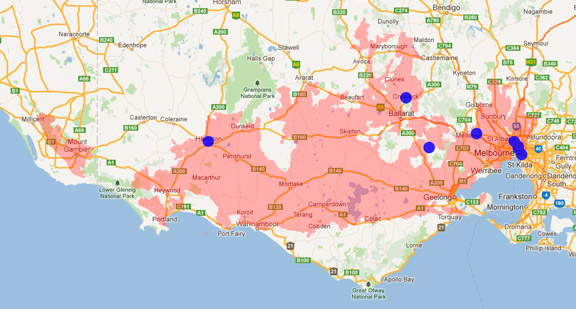A range of teacher professional learning programs will be developed to accompany the Biodiversity of the Western Volcanic Plains online outreach...

Garden Orb-weaver
Eriophora transmarina
Nocturnal. Female Garden Orb-weavers live about twelve months. Eggs are laid late summer-autumn and the female usually dies by early winter. The egg case is a fluffy silken cocoon attached to foliage. The spiderlings hatch and disperse during autumn to build their own tiny orb webs among vegetation. During spring the spiderlings develop more quickly and mature during summer.
| Details | Description |
| Type | Invertebrate |
| Group | Arachnid - Spider |
| Identifying Characteristics | |
| Distinctive Markings | Slightly furry-looking bodies and legs. Vertical, wheel-shaped, sticky webs are built in openings between trees and shrubs where insects are likely to fly. |
| Diet | Carnivore. Common prey are flying insects including flies, beetles and bugs. The spider is eaten by birds such as honeyeaters. |
| Habitat | During the day the spider rests on foliage near its web, with its legs held under its body. It usually builds its web in the evenings and rests head-down in the centre of the web, waiting for prey. The web may be dismantled at dawn. |
| Native Status | Native to Australia |
| Bites/Sting | Orb weavers rarely bite. Symptoms are usually not noticeable or mild local pain, numbness and swelling. Occasionally nausea and dizziness occurs. |
| Taxonomy | |
| Phylum | Arthropoda |
| Class | Arachnida |
| Order | Araneae |
| Family | Araneidae |
| Genus | Eriophora |
| Species | transmarina |

Distribution maps indicate current and historic locations where species have been sighted.
Source: Atlas of Living Australia
| Conservation Status | |
| DEPI Advisory List | Not listed |
| FFG Act | Not listed |
| EPBC Act | Not listed |
The conservation status of species is listed within Victoria and Australia.
The Department of Environment and Primary Industry (DEPI) Advisory List consists of non-statutory advisory lists of rare or threatened flora and fauna within Victoria.
The Flora and Fauna Guarantee Act 1988 (FFG Act) lists threatened species in Victoria. Under the Act, an Action Statement is produced for each listed species.
The Environment Protection and Biodiversity Conservation Act 1999 (EPBC Act) is the Australian Government’s key piece of environmental legislation, listing nationally threatened native species and ecological communities.



